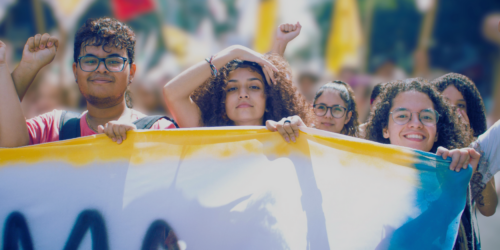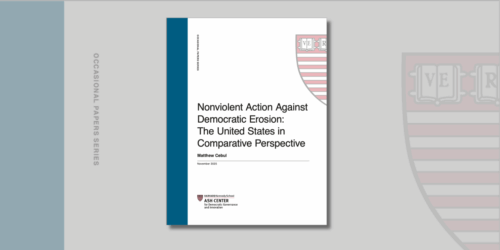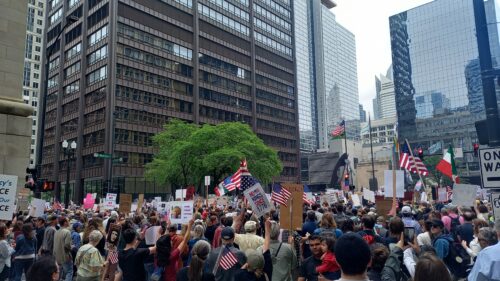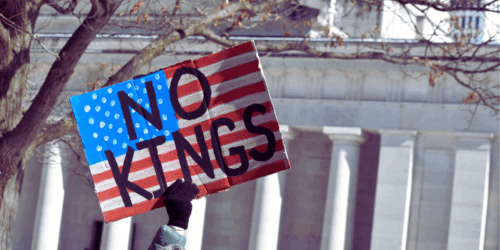
Policy Brief
Why Gen-Z Is Rising
Erica Chenoweth and Matthew Cebul analyze the global surge of Gen Z-led protest movements, showing how economic insecurity, exclusion from power, and corruption are driving youth mobilization worldwide.
Commentary
New Crowd Counting Consortium analysis from Nonviolent Action Lab Program Director Jay Ulfelder sets the record straight on arrests numbers and claims of violence stemming from protests sparked by the war in Gaza.
Protest encampments have sprung up over the past few weeks on more than 100 college and university campuses across the country, and they have rightly drawn national attention to the pro-Palestinian movement of which they are now a crucial part. A few things seem to be getting lost in the coverage of those encampments, however.
First, while the recent crescendo of activity at colleges and universities has caught the national eye, this movement is not primarily a student or campus-centered movement.
Since October 7, 2023, our project has logged more than 10,000 pro-Palestinian protests nationwide.1 As you can see in the chart below, however, the vast majority of relevant events we’ve recorded over the past seven months—about 7 of every 10—have occurred away from campuses, not on them.

The same is true of arrests made at these events. Of the more than 8,600 arrests we’ve logged at pro-Palestian protests nationally since October 7, about two-thirds of them (5,671 of 8,609) have occurred away from campuses. In other words, far more people have been arrested while participating in this movement away from schools than at them.
One element of the movement driving this pattern is the spread and staying power of routinized actions—demonstrations or vigils that recur monthly, weekly, or even daily. At this point, our project is tracking scores of those nationwide, and they add up to hundreds of events each week. These repetitive actions typically draw little media attention, but they are an important indication of a movement’s salience and staying power. The last time we saw routinized demonstrations emerge and persist at this scale was in 2020, after the murder of George Floyd. These actions typically involve small numbers of people, but, as organizers and participants will tell you, they can have outsized impacts on local and regional politics that persist for years.
Second, this movement has not been violent. That’s true of the broader national wave in general, and of the recent student encampments in particular.
Our project tracks several features of protest events that might be construed as indicators of protester violence, including property damage caused by protesters and injuries to police present at the event. In the more than 10,000 pro-Palestine actions we have recorded since October 7, we have only seen property damage at 128 of them and police injuries at 13. The vast majority of the instances of property damage involved graffiti or similar defacement of property, and virtually all of the police injuries occurred while making arrests. If we look only at actions on school campuses, the incidence of property damage is 30 and police injuries 6, with similar caveats about the what and the how.
Some observers might read the high arrest count as an indicator of violence. In fact, as the chart below shows, the vast majority of arrests have occurred during acts of civil disobedience or direct action that may have disrupted traffic but did not target any people or property for harm. Most of the recent arrests have happened on campuses, but these have generally come in response to concerns about the camp’s purported disruptions to academic life, not any physical injuries they have caused to other people.

In fact, we’ve seen far more violence directed at people protesting for Palestinian liberation or against genocide than we’ve seen from them. The pre-dawn mass assault on the student encampment at UCLA is the most glaring example, but hardly the only one. Just in the past week, we’ve seen people drive cars through crowds of pro-Palestinian or anti-genocide protesters four times, at least one of them causing injury (see here, here, here, and here); a counter-protester wearing brass knuckles push and slap medical students gathering to walk to a rally; a counter-protester brandish a knifeat students; a trio of flag-wearing counter-protesters arrive at a encampment before dawn to heckle and verbally threaten students there… The list goes on, and it does not include the scores of uncounted injuries suffered by protesters during police sweeps of campus encampments in places like St. Louis, Los Angeles, and D.C.
Last but certainly not least, the rhetorical core of this movement has not been a call for violence against Jews, but rather a call for freedom for Palestinians and an end to violence being inflicted upon them.
Take a look at the word cloud below, which shows the relative frequency of the words we’ve seen on banners and signs or heard in chants from these events since October 7.2 The six most common words are Palestine, free, genocide, Gaza, ceasefire, and stop. Based on the thousands of video clips, photos, and dispatches I’ve watched and read from these actions, I would summarize their collective message as “free Palestine,” “stop genocide,” and, more specifically, “stop killing kids,” the latter sometimes with a “…with our taxes/tuition” addendum. When protesters—some of them Jewish, some of them not—have been asked specifically about slogans like “From the river to the sea,” they have almost invariably explained them as positive demands for freedom and human rights and dignity for Palestinians, rather than calls for violence against Israelis or Jews.

There’s much more to say about this movement, of course. In the interest of my time and your attention, however, I’m going to leave it there for now. To stay up to date on what our data show about its persistence and evolution, you can use the interactive maps and dashboards we’ve created to track (crudely speaking) pro-Palestine and pro-Israel protest activity since October 7. And, as always, you can freely download the entirety of our dataset on U.S. protest activity since January 2017, and find more information about what it contains and how we collect it, from our GitHub repository.
FOOTNOTES
We only post records that we can confirm and verify through fact-checking. When you submit a record, be sure to provide a source that is publicly verifiable (e.g. a news report, a Facebook group, links to online photos with headcounts, etc) or describe the crowd-counting techniques used by onsite onlookers (e.g. sign-ins, counting through distributing flyers/handouts, counting from photos/videos, and/or other crowd density estimation techniques).
We will never post, release, or share identifying information that has not already been reported in the public domain.
Nevertheless, we urge you to avoid including personal identifying information in your submission.
Policy Brief
Erica Chenoweth and Matthew Cebul analyze the global surge of Gen Z-led protest movements, showing how economic insecurity, exclusion from power, and corruption are driving youth mobilization worldwide.
Occasional Paper
In this report, Matthew Cebul, Lead Research Fellow for the Nonviolent Action Lab, examines the effectiveness of nonviolent action movements in supporting democratic resilience globally. Identifying challenges faced by nonviolent pro-democracy movements, Cebul offers key takeaways for combating accelerating democratic erosion in the US and abroad.
Article
As organizers for No Kings 2 seek historic turnout on October 18, the broader pro-democracy movement has already broken new ground.
Policy Brief
Erica Chenoweth and Matthew Cebul analyze the global surge of Gen Z-led protest movements, showing how economic insecurity, exclusion from power, and corruption are driving youth mobilization worldwide.
Occasional Paper
In this report, Matthew Cebul, Lead Research Fellow for the Nonviolent Action Lab, examines the effectiveness of nonviolent action movements in supporting democratic resilience globally. Identifying challenges faced by nonviolent pro-democracy movements, Cebul offers key takeaways for combating accelerating democratic erosion in the US and abroad.
Article
In this op-ed, Liz McKenna examines the second ‘No Kings’ protest on October 18 and offers strategies for translating successful protest movements into influential policy change. She emphasizes the importance of sustained organizational efforts alongside protest activity to engage actors across partisan lines, building a broad coalition and a durable base for the movement.



